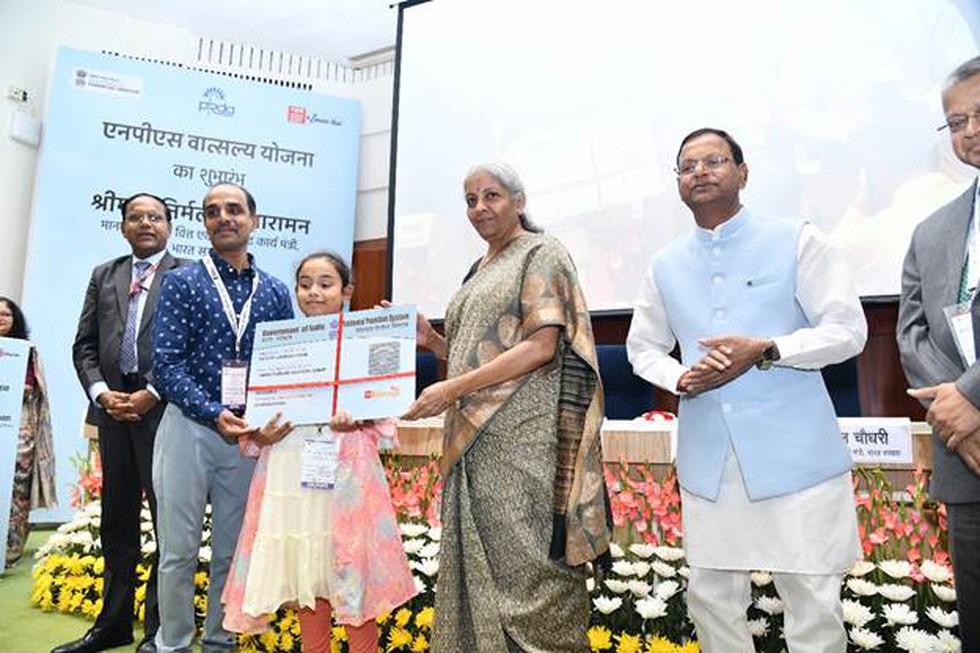On Tuesday, Union Finance Minister Nirmala Sitharaman officially launched the NPS Vatsalya scheme. Managed by the Pension Fund Regulatory and Development Authority (PFRDA), this initiative aims to help parents secure long-term wealth for their children by investing in retirement funds at an early age.
Launch of NPS Vatsalya
The launch took place across 75 locations in India, with video conferencing for additional locations. New minor subscribers at these locations received Permanent Retirement Account Number (PRAN) membership cards, signaling their inclusion in the scheme.
ICICI Bank’s Role in the Scheme
ICICI Bank announced its participation in the NPS Vatsalya launch at its service center in Mumbai, Maharashtra. ICICI Bank has equipped its business centers nationwide to open NPS Vatsalya accounts for customers. A symbolic PRAN card was given to children who registered their NPS Vatsalya accounts on the launch day.
Overview of NPS Vatsalya
NPS Vatsalya is an extension of the National Pension Scheme (NPS) that specifically focuses on children. Like the NPS, it allows parents to invest in market-linked securities, including equities and bonds, offering the potential for higher returns than traditional fixed-income investments.
Features of NPS Vatsalya
- Starting Early: Parents can begin saving for their child’s retirement right from infancy, providing significant long-term financial growth through compounding.
- Investment Options: Contributions can be made through Points of Presence (POPs), including major banks and India Post, or online via e-NPS.
- Flexibility: Families can contribute as little as ₹1,000 annually, making it accessible to a wide range of economic backgrounds.
- Seamless Transition: Once the child turns 18, the account automatically transitions to a standard NPS account. If the corpus is below ₹2.5 lakh, the entire amount can be withdrawn. For amounts exceeding ₹2.5 lakh, 20% can be withdrawn, with 80% invested in an annuity.
Eligibility and Investment Choices
- Eligibility: The child must be under 18 years old, and both the child and parent must be Indian citizens. Compliance with KYC norms is mandatory.
- Investment Choices:
- Default Choice: 50% of funds are invested in equities.
- Auto Choice (Life Cycle Funds): Investments adjust based on age with three sub-options:
- Aggressive (75% equity).
- Moderate (50% equity).
- Conservative (25% equity).
- Active Choice: Parents decide how to allocate funds, with options for equity, corporate debt, government securities, and alternative assets.
Withdrawal Options
- Partial Withdrawals: After three years, up to 25% of the corpus can be withdrawn for education, medical treatment, or disabilities. Subscribers can make up to three partial withdrawals before the child turns 18.
- Post-18 Withdrawals: Once the subscriber turns 18, they can withdraw up to ₹2.5 lakh entirely. For larger amounts, 20% can be withdrawn, with the remainder invested in an annuity.
Nominee and Guardian Provisions
In the event of the subscriber’s death, the entire corpus goes to the nominee, typically the guardian. If both parents die, a legal guardian can manage the account without further contributions until the child turns 18.
Multiple-Choice Questions (MCQs):
- What is the primary objective of the NPS Vatsalya scheme?
- a) To provide short-term wealth for children.
- b) To secure long-term wealth for children’s retirement.
- c) To offer immediate financial support to families.
- d) To fund higher education for children.
Answer: b) To secure long-term wealth for children’s retirement.
- Which organization manages the NPS Vatsalya scheme?
- a) Reserve Bank of India (RBI).
- b) Insurance Regulatory and Development Authority (IRDAI).
- c) Pension Fund Regulatory and Development Authority (PFRDA).
- d) National Bank for Agriculture and Rural Development (NABARD).
Answer: c) Pension Fund Regulatory and Development Authority (PFRDA).
- What is the minimum annual contribution required to start an NPS Vatsalya account?
- a) ₹500.
- b) ₹1,000.
- c) ₹10,000.
- d) ₹5,000.
Answer: b) ₹1,000.
- What happens when the child reaches 18 years of age in the NPS Vatsalya scheme?
- a) The account is closed automatically.
- b) The corpus is fully withdrawn.
- c) The account transitions into a standard NPS account.
- d) Contributions are doubled by the government.
Answer: c) The account transitions into a standard NPS account.
- What is the maximum percentage of equity investment allowed under the Active Choice option?
- a) 50%.
- b) 75%.
- c) 100%.
- d) 25%.
Answer: b) 75%.
- How many partial withdrawals are allowed before the subscriber turns 18?
- a) One.
- b) Two.
- c) Three.
- d) Unlimited.
Answer: c) Three.
